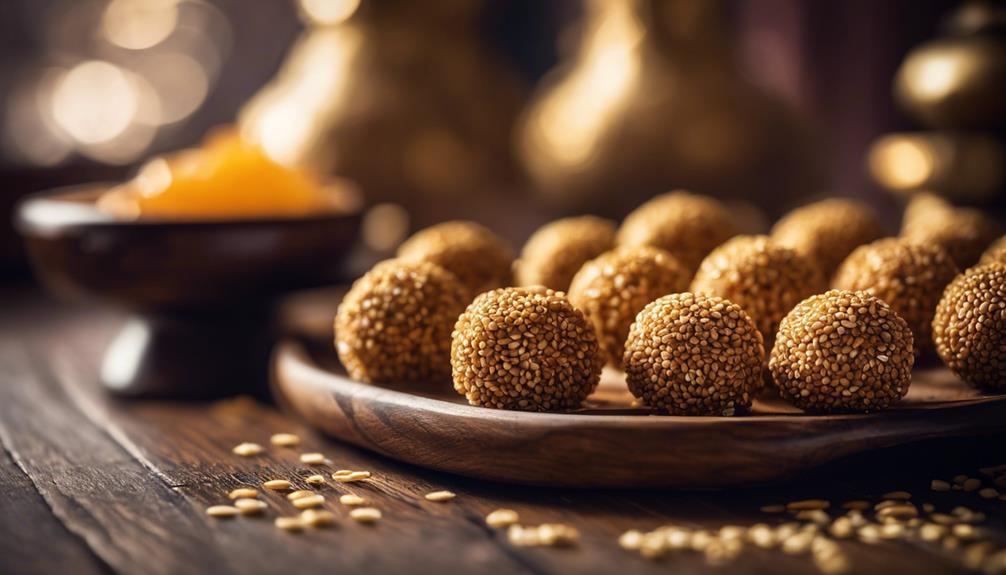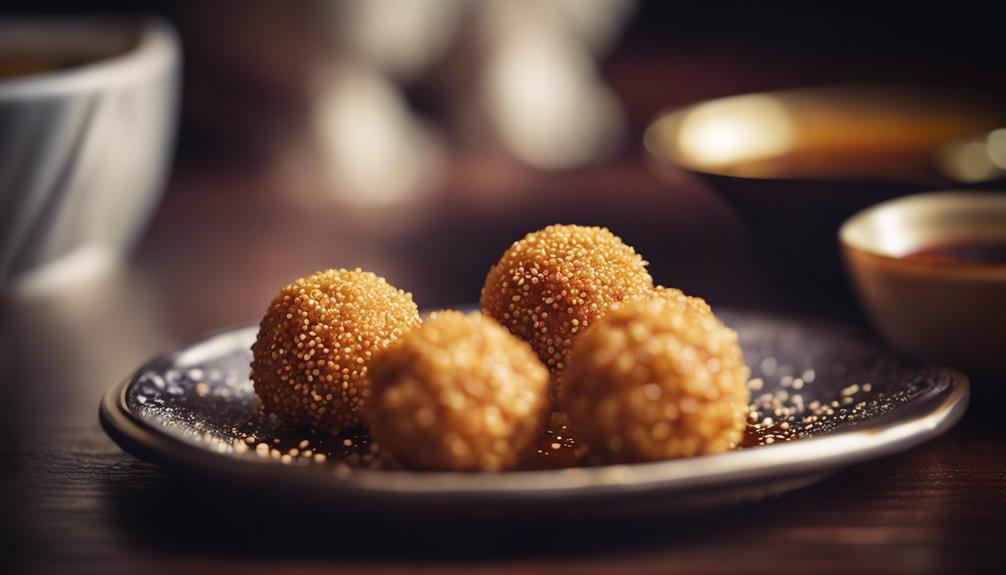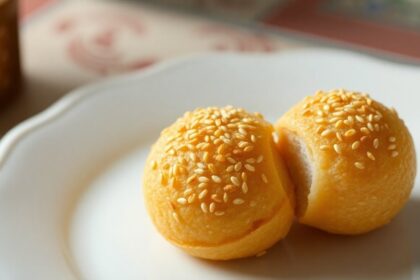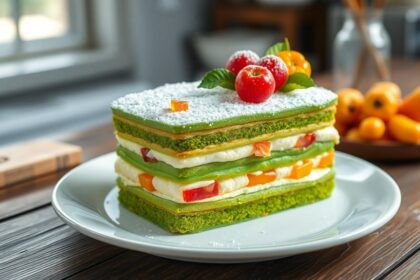Plunge into the rich tradition of sesame balls, a delightful Cantonese treasure symbolizing luck and prosperity. Made with glutinous rice flour for that chewy bite and encased in crispy sesame seeds, these treats offer a perfect blend of textures and flavors. Whether filled with sweet red bean paste or other delicious surprises, each bite is a burst of cultural fusion and culinary expertise. Learn how to achieve the ideal texture, fry to golden perfection, and serve with flair. Uncover the secrets of creating and savoring this iconic delight for a taste of culinary history and fusion at its finest.
Fried Sesame Balls: Lunar New Year Delight
If you're interested in savoring a traditional Chinese dessert during Lunar New Year festivities, Fried Sesame Balls, also known as Jian Dui, are a must-try pleasure.
These delightful treats are crafted using glutinous rice flour and filled with a delicious sweet red bean paste, creating a pleasant contrast of textures. The sesame balls are then coated with sesame seeds before being deep-fried to a crispy perfection, offering a satisfying crunch with a hint of nuttiness.
To prepare these Lunar New Year delights, red beans are soaked overnight, and a dough is carefully made using sugar syrup. The precise frying process guarantees that the sesame balls achieve a golden brown hue, symbolizing luck and prosperity in Chinese culture.
Representing good fortune, these sesame balls aren't only a delight for the taste buds but also hold a significant place in the hearts of those commemorating festive occasions.
Gato Zinzli: Culinary Harmony Emblem
Let's begin by acknowledging the cultural fusion represented in Gato Zinzli, showcasing the harmonious blend of flavors and techniques from various culinary traditions.
Understanding the importance of ingredient selection in this Mauritian delicacy is key to appreciating the unique balance of textures and tastes that make it a true emblem of culinary harmony.
Cultural Fusion Representation
Incorporating a blend of cultural influences, Gato Zinzli stands as a culinary emblem representing the harmonious fusion of flavors in Mauritian cuisine. This traditional snack, often referred to as Sesame Balls, embodies the essence of cultural fusion through its use of ingredients like glutinous rice flour and sweet paste, creating a unique and delightful treat enjoyed by many in Mauritius.
Here are three key aspects that showcase the cultural fusion representation in Gato Zinzli:
- Multicultural Identity: Gato Zinzli symbolizes the diverse culinary heritage of Mauritius, blending influences from various cultures into a single delectable snack.
- Generational Tradition: Passed down through generations, the preparation and enjoyment of Gato Zinzli reflect the ongoing fusion of flavors and traditions within Mauritian families.
Ingredient Selection Importance
Gato Zinzli's culinary significance lies in the meticulous selection of ingredients like glutinous rice flour, sesame seeds, jaggery, and coconut, which play an essential role in shaping its distinctive flavor profile. The careful combination of glutinous rice flour and jaggery brings a delicate sweetness to the snack, while the nuttiness of sesame seeds and the tropical hint of coconut add layers of flavor complexity. Each ingredient contributes to the unique taste that represents the multicultural culinary identity of Mauritius.
The fusion of these ingredients not only enhances the taste and texture of Gato Zinzli but also reflects the diverse cultural influences present in Mauritian cuisine. The balance of flavors achieved through the precise selection of glutinous rice flour, sesame seeds, jaggery, and coconut highlights the craftsmanship and attention to detail involved in creating this beloved traditional snack.
Next time you indulge in a Gato Zinzli, appreciate how each ingredient harmoniously comes together to create a delightful culinary experience.
History and Significance of Sesame Balls

You'll discover the fascinating history and cultural significance behind sesame balls, a beloved Chinese treat.
Explore how these delectable snacks originated in Cantonese cuisine and their symbolism in representing prosperity and good luck.
Learn how sesame balls continue to hold a special place in Chinese culinary traditions, especially during festive occasions like Chinese New Year.
Origin of Sesame Balls
Sesame balls, also known as jian dui or jin dui in Cantonese cuisine, have a rich history and significant cultural symbolism. These delectable treats aren't only beloved during Chinese New Year celebrations but are also staples on dim sum menus, delighting palates with their unique blend of textures and flavors.
The origins of sesame balls can be traced back to Cantonese cuisine, where they were traditionally served during special occasions like Chinese New Year, symbolizing prosperity and good luck.
A key component of sesame balls is glutinous rice flour, which gives them their signature chewy texture, while sesame seeds provide a delightful crunch.
Among the various fillings used in sesame balls, red bean paste stands out for its sweetness and traditional appeal, although creative variations like seafood fillings can offer a unique twist to this classic snack.
Symbolism in Ingredients
Within Chinese culinary traditions, the symbolism behind the ingredients used in sesame balls holds a significant historical and cultural importance.
Glutinous rice flour, a fundamental component of sesame balls, contributes to their distinctive sticky and chewy texture that complements the crispy sesame seed coating.
The sesame seeds, which cover the exterior of the balls, embody yang energy in Chinese philosophy, enhancing the overall flavor profile with their nutty and crunchy characteristics.
Furthermore, the fillings found within sesame balls play an essential role in diversifying the flavors and textures of this traditional delight. Options like red bean paste, lotus seed paste, and black sesame paste offer a range of tastes that cater to different preferences.
These fillings, combined with the glutinous rice flour and sesame seeds, create a harmonious blend of textures and flavors that make sesame balls a beloved dessert in Chinese cuisine.
Cultural Significance Today
Originating in Cantonese cuisine, jian dui, popular during Chinese New Year and dim sum menus, holds significant cultural significance today. Sesame Balls, also known as jian dui, have become more than just a delicious Chinese dessert. Here's why they remain culturally relevant:
- Red Symbolism: The use of red bean paste or other red fillings in Sesame Balls symbolizes good luck and prosperity in Chinese culture.
- Traditional Chinese Dessert: Sesame Balls are a staple in Chinese cuisine, showcasing the rich culinary heritage and traditions passed down through generations.
Sesame Balls continue to bridge the past with the present, offering a taste of history and cultural significance with every crunchy bite.
Creating the Perfect Texture and Forming
To achieve the ideal texture and shape for sesame balls, make sure that you use glutinous rice flour for its sticky and chewy consistency. This type of flour is essential in creating the signature texture of sesame balls.
When forming the sesame balls, remember to knead the dough properly to activate the gluten, which gives elasticity and enhances the overall texture. As you shape the dough into balls, make sure there's a tasty filling in the center, such as diced prawns or crab meat for a unique flavor.
Rolling the dough balls to smooth out any creases is vital to achieve a round and uniform shape. Once the sesame balls are filled and shaped, deep fry them to perfection. This process not only cooks the dough but also gives the sesame balls a crispy exterior while keeping the inside moist and flavorful.
Frying, Serving, and Storage Tips

For best results, the next step after forming the sesame balls is to focus on frying, serving, and storing them properly.
When preparing your sesame balls, keep these tips in mind:
- Fry sesame balls in vegetable oil: Achieve a crispy texture by frying your sesame balls in vegetable oil at 170-180°C until they turn a beautiful golden brown.
- Roll in black sesame seeds: For an eye-catching finish, roll your sesame balls in a mixture of black and white sesame seeds before frying.
If you wish to reheat them, consider using the oven to help preserve their crispiness when enjoying them later.
Storing Leftovers and Healthy Variations
Consider storing leftover sesame balls in the fridge in an airtight container to maintain their freshness and flavor. For longer storage, freezing them is a great option. Place the sesame balls in a sealed container and freeze them for up to 3 months. When you're ready to enjoy them, simply thaw them at room temperature or gently reheat in the microwave.
Looking to explore healthier variations? Try baking sesame balls instead of deep-frying them. This method can help reduce the overall oil content while still giving you that delightful crunch. Additionally, you can swap out some of the glutinous rice flour with whole wheat flour to add a bit of fiber to your treat. This simple adjustment can make your sesame balls a bit healthier without compromising on taste.
Conclusion
You've now mastered the art of making sesame balls, a traditional delight that has been enjoyed for centuries.
Did you know that over 5 billion sesame balls are consumed in China during the Lunar New Year festivities each year? Now that's a lot of delicious treats to celebrate with!
Keep experimenting with different fillings and flavors to create your own unique twist on this classic dish.
Happy cooking!





